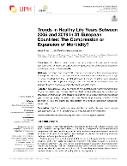Trends in Healthy Life Years Between 2005 and 2019 in 31 European Countries: The Compression or Expansion of Morbidity?

Publication date
2024Published in
International Journal of Public HealthVolume / Issue
69 (October)ISBN / ISSN
ISSN: 1661-8556ISBN / ISSN
eISSN: 1661-8564Metadata
Show full item recordCollections
This publication has a published version with DOI 10.3389/ijph.2024.1607574
Abstract
Objectives: Our objective was to assess morbidity trends in Europe and to classify European countries based on population ageing theories: the compression, expansion and dynamic equilibrium of morbidity.Methods: The proportions of healthy life years were calculated for 31 European countries for the period 2005-2009 based on life expectancy values and healthy life years at age 65 years adopted from the Eurostat database. European countries were classified according to morbidity patterns applying the standard deviation distance from the average of relative change method between the selected years.Results: A large degree of variation in terms of life expectancy and healthy life years at age 65 years was determined between 2005 and 2019. While the life expectancy differences between men and women were consistent across all the European countries, the gender gap concerning healthy life years was more diverse. Approximately one-third of the countries fell into the expansion, compression and dynamic equilibrium categories, respectively.Conclusion: Significant variations were identified in healthy life year trends across European countries, which underscores the need for preventive strategies.
Keywords
healthy life years, population ageing, compression, expansion, dynamic equilibrium
Permanent link
https://hdl.handle.net/20.500.14178/2708License
Full text of this result is licensed under: Creative Commons Uveďte původ 4.0 International






